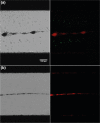MicroBubble activated acoustic cell sorting
- PMID: 28374278
- PMCID: PMC5378755
- DOI: 10.1007/s10544-017-0157-4
MicroBubble activated acoustic cell sorting
Abstract
Acoustophoresis, the ability to acoustically manipulate particles and cells inside a microfluidic channel, is a critical enabling technology for cell-sorting applications. However, one of the major impediments for routine use of acoustophoresis at clinical laboratory has been the reliance on the inherent physical properties of cells for separation. Here, we present a microfluidic-based microBubble-Activated Acoustic Cell Sorting (BAACS) method that rely on the specific binding of target cells to microbubbles conjugated with specific antibodies on their surface for continuous cell separation using ultrasonic standing wave. In acoustophoresis, cells being positive acoustic contrast particles migrate to pressure nodes. On the contrary, air-filled polymer-shelled microbubbles being strong negative acoustic contrast particles migrate to pressure antinodes and can be used to selectively migrate target cells. As a proof of principle, we demonstrate the separation of cancer cell line in a suspension with better than 75% efficiency. Moreover, 100% of the microbubble-cell conjugates migrated to the anti-node. Hence a better upstream affinity-capture has the potential to provide higher sorting efficiency. The BAACS technique expands the acoustic cell manipulation possibilities and offers cell-sorting solutions suited for applications at point of care.
Keywords: Acoustophoresis; Cell sorting; Contrast agent; Microbubble; Microfluidic separation.
Figures





References
Publication types
MeSH terms
LinkOut - more resources
Full Text Sources
Other Literature Sources
Research Materials

